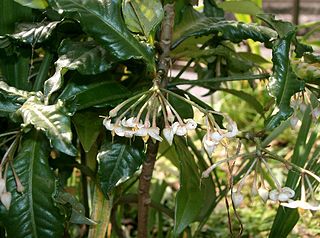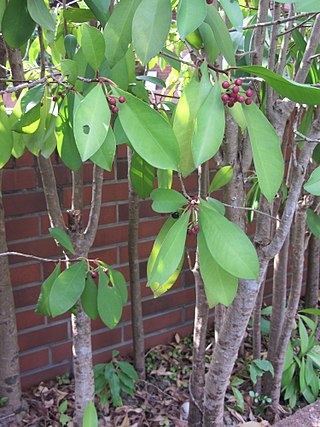
Myrsinoideae is a subfamily of the family Primulaceae in the order Ericales. It was formerly recognized as the family Myrsinaceae, or the myrsine family, consisting of 35 genera and about 1000 species. It is widespread in temperate to tropical climates extending north to Europe, Siberia, Japan, Mexico, and Florida, and south to New Zealand, South America, and South Africa.

Ardisia crenata is a species of flowering plant in the primrose family, Primulaceae, that is native to East Asia. It is known by a variety of names such as Christmas berry, Australian holly, coral ardisia, coral bush, coralberry, coralberry tree, hen's-eyes, and spiceberry. A. crenata is a compact shrub that reaches 1 metre (3.3 ft), often with a single stem. Leaves are dark green, thick, glossy, and have tightly waved edges The flowers are small, white or reddish, fragrant, and form clusters. The fruit is a glossy, bright red drupe. The seeds are able to germinate under a dense canopy and are dispersed by birds and humans.

Ardisia is a genus of flowering plants in the family Primulaceae. It was in the former Myrsinaceae family now recognised as the myrsine sub-family Myrsinoideae. They are distributed in the Americas, Asia, Australia, and the Pacific Islands, mainly in the tropics. There are over 700 accepted species. One species, Ardisia japonica is one of the 50 fundamental herbs in traditional Chinese medicine.

Ardisia japonica, known as marlberry, is a species of Ardisia native to eastern Asia, in eastern China, Japan and Korea.

Ardisia elliptica is an evergreen tree, also known as the shoebutton ardisia, duck's eye and coralberry, native to the west coast of India, Sri Lanka, Indochina, Malaysia, Indonesia and New Guinea. It is a prolific reproducer which has made it a successful invasive species in other locations in the tropics where it has been introduced as a garden ornamental.

Ardisia humilis is a species of flowering plant in the genus Ardisia in the family Primulaceae, native to southeastern Asia in southern China, the Philippines, and Vietnam.
Ardisia alstonii is a species of plant in the family Primulaceae. It is endemic to Panama. It is threatened by habitat loss.
Ardisia blatteri is a species of plant in the family Primulaceae. It is endemic to India.
Ardisia flavida is a species of plant in the family Primulaceae. It is endemic to Ecuador.
Ardisia furfuracella is a species of plant in the family Primulaceae. It is found in Costa Rica and Panama.
Ardisia geniculata is a species of plant in the family Primulaceae. It is endemic to Panama.
Ardisia koupensis is a species of plant in the family Primulaceae. It is endemic to Cameroon. Its natural habitat is subtropical or tropical moist lowland forests. It is threatened by habitat loss.
Ardisia schlechteri is a species of flowering plant in family Primulaceae. It is endemic to Cameroon. Its natural habitat is subtropical or tropical dry forests. It is threatened by habitat loss.
Ardisia scortechinii is a species of plant in the family Primulaceae. It is a tree endemic to Peninsular Malaysia.
Ardisia sonchifolia is a species of plant in the family Primulaceae. It is endemic to India.

Ardisia squamulosa is a species of plant in the family Primulaceae. It is endemic to the Philippines. It is used to flavor fish.

Corydalis solida, fumewort or bird-in-a-bush, is a species of flowering plant in the family Papaveraceae, native to moist, shady habitats in northern Europe and Asia. Growing to 25 cm (10 in), it is a spring ephemeral, with foliage that appears in spring and dies down to its tuberous rootstock in summer. It is cultivated for its deeply divided, ferny leaves and narrow, long-spurred flowers which appear in spring. The flowers show color variation, and may be mauve, purple, red, or white.
Ardisia helferiana is a species of flowering plant in the genus Ardisia in the family Primulaceae. Growing as a shrub, it occurs in Mainland Southeast Asia. The plant is used for food, fuel and medicine.

Ardisia crispa, the Japanese holly, is a species of flowering plant in the family Primulaceae. It is found in the eastern Himalayas, Assam, southern China, Indochina, Taiwan, Korea, the Ryukyu Islands, and Japan, and has been introduced to Queensland, Australia, and the Windward Islands in the Caribbean. An evergreen perennial shrub reaching at most 1.5 m (5 ft), it is often sold as an ornamental for its dark green leaves and long‑lasting red berries, much like Ardisia crenata, the Christmas berry or coralberry.








